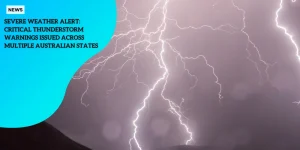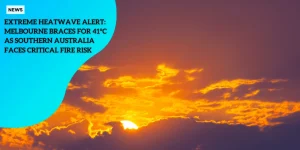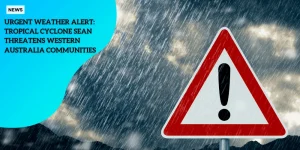Extreme Weather Warning: Severe Heatwave and Coastal Storms Divide Australia This Weekend

Anúncios
Overview of Weather Extremes
This weekend, Australia is bracing for a sharp contrast between extreme weather conditions in inland and coastal regions.
Inland Australia is set to endure a severe heatwave, with temperatures soaring into the mid-40s Celsius.
Anúncios
Counteracting this intense heat, coastal areas are expecting thunderstorms and heavy rainfall, highlighting the stark weather divide across the country.
Heatwave Conditions in Inland Australia
The Bureau of Meteorology has issued extensive weather warnings due to the anticipated extreme temperatures.
Anúncios
Northern and inland areas of Australia, including most of the Northern Territory, inland Queensland, and Western Australia, are under severe heatwave warnings.
These regions can expect maximum temperatures ranging from the low to mid-40s.
Specific regions such as the Northern Territory’s southeast corner, Western Australia’s South Interior, and South Australia’s North West Pastoral District are forecasted to experience some of the highest temperatures.
Overnight minimums in these areas will also be uncomfortably high, staying in the mid to high 20s Celsius.
These oppressive conditions are expected to persist into next week for Queensland’s Channel Country, with severe heatwaves intensifying and overnight temperatures remaining in the low 30s.
Coastal Storms and Rainfall
While the interior swelters, the coastal regions of Australia are prepared for a wetter climate this weekend.
Cities such as Sydney, Brisbane, and the Gold Coast are expecting thunderstorms and heavy rainfall.
The eastern coast will face rainy conditions with forecasts showing storms across both days.
Severe weather warnings are currently active for much of Queensland’s southeast inland due to the anticipated heavy rains.
These warnings extend to the Wide Bay and Burnett, Southeast Coast, and Darling Downs and Granite Belt districts.
This dynamic weather pattern provides a significant contrast to the scorching conditions inland, emphasizing the weather divide across the nation.
Moving forward, it’s crucial to monitor weather updates and heed all warnings issued by the Bureau of Meteorology.
The varying extreme conditions are not only challenging for residents but also pose various risks that require immediate attention.

Heatwave Impact Zones
Australia’s vast inland areas are currently facing an intense heatwave, with several regions under severe warnings.
The Bureau of Meteorology has issued heatwave alerts for most of the Northern Territory, inland Queensland, and Western Australia, signifying serious health risks and other hazards.
Northern Territory, Queensland, and Western Australia
The Northern Territory’s southeast corner is experiencing scorching temperatures, driving the mercury up to the low to mid-40s.
Overnight lows hardly provide relief, dipping only to the mid to high 20s. Inland Queensland, particularly the Channel Country, faces even more arduous conditions.
Thermometers are anticipating peaks of around 46 to 47 degrees Celsius, with heatwave conditions expected to persist into the following week.
Western Australia’s South Interior mirrors these patterns of extreme highs and oppressive nights, emphasizing the severe heat scenario engulfing inland Australia.
South Australia’s North West Pastoral District
South Australia’s North West Pastoral District is another critical area affected by the heatwave.
The region is grappling with extreme daytime temperatures reaching up to the low 40s and high 20s during the night.
The persistent high temperatures pose serious fire risks, with conditions ripe for bushfires and other heat-related emergencies.
Unusual Heat in Western Tasmania
Tasmania, known for its cooler climate, is remarkably experiencing unusual heat conditions, particularly in the North West Coast and Furneaux Islands.
Over the weekend, temperatures in these areas are reaching the high 20s to low 30s, significantly warmer than the norm.
While this might seem mild compared to the soaring 40s elsewhere, it is notably atypical for the region and has prompted concerns.
The ongoing heatwave in these inland areas contrasts sharply with the wet conditions anticipated along the coastal cities.
As we journey from these blazing interiors to the cooler coastal regions, we’ll delve into the specific weather scenarios playing out there.
Temperature Forecasts
Australia’s heatwave conditions are set to intensify, particularly in Western Queensland, where maximum temperatures are forecast to reach a scorching 46 to 47 degrees Celsius.
This extreme heat is not just limited to the daylight hours but continues into the night, as overnight minimums remain alarmingly high, in the mid to high 20s.
Maximum Temperature Spikes
Western Queensland is bracing for a grueling start to the week, with the mercury expected to peak at unprecedented levels.
Specifically, temperatures could soar between 46 and 47 degrees Celsius, pushing the limits of what these regions can handle.
This spike is significant and poses critical challenges for both the people and the environment in these areas.
High temperatures such as these make it nearly impossible for the ground to cool sufficiently overnight, leading to a cumulative heat effect.
High Overnight Minimums
While intense daytime heat is detrimental, the high overnight minimums expected in the affected regions are also a cause for concern.
With temperatures predicted to remain in the mid to high 20s throughout the night, there will be little relief for communities.
The consistent heat escalation prevents the environment from cooling off and adds to the strain on infrastructure, wildlife, and human health.
Channel Country Concerns
One area that will particularly feel the brunt of prolonged severe conditions is Queensland’s Channel Country.
This region is not only facing high daytime temperatures but the severe heatwave is expected to extend well into the next week.
As the thick blanket of heat persists, it could lead to worsening conditions and increased risks, such as higher fire danger and severe stress on local ecosystems.
Weather authorities highlight the need for preparedness in these regions, particularly with such extreme overnight temperatures.
The prediction of these prolonged and intense heat conditions underlines the importance of vigilance and adaptive measures to combat the harsh weather elements.
The scenario presents a clear danger and prompts a need for communities to heed warnings, stay hydrated, and ensure that vulnerable groups, including the elderly and young children, are protected.
As the inland regions of Australia sizzle, the focus shifts to the contrasting weather conditions expected along the coastal areas, which are set to face their own set of challenges.
Associated Risks and Warnings
The current weather conditions across Australia bring along several associated risks and warnings, especially due to the severe heatwaves and impending heavy rainfall.
These conditions, impacting vast swathes of the country, necessitate heightened vigilance and preparedness.
High Fire Danger Ratings
With the sweltering heat affecting most of inland Australia, high fire danger ratings have been issued for South Australia and Western Australia.
The extreme temperatures, combined with dry conditions, create a volatile environment prone to bushfires.
Regions like South Australia’s North West Pastoral District and parts of Western Australia are particularly susceptible.
Residents in these areas should remain alert, adhere to fire bans, and have emergency plans in place to safeguard against potential outbreaks.
Severe Weather Warnings for Queensland’s Inland Regions
Meanwhile, as inland Queensland grapples with soaring temperatures in the mid-40s Celsius, the weather bureau has issued severe weather warnings for the state’s south-east inland regions.
This area is bracing for intense weather conditions, potentially exacerbating the challenges posed by the extreme heat.
It is crucial for communities to stay informed through updates from the Bureau of Meteorology and take necessary precautions to mitigate the impact of these severe warnings.
Heavy Rainfall Alerts for Coastal Districts
On the eastern coast, the forecast stands in stark contrast to the inland heatwave.
Heavy rainfall alerts have been issued for the Wide Bay, Burnett, and Southeast Coast districts of Queensland.
These areas, including bustling cities such as Brisbane and the Gold Coast, can expect substantial rainfall and thunderstorms.
The persistent heavy downpours may lead to flooding in low-lying regions and disrupt travel plans.
Residents and tourists in these districts should be cautious, avoid navigating through flooded areas, and monitor local news for weather updates.
Adaptation and Preparedness
Given the severity and variance of these weather events, it is essential for all affected regions to prioritize adaptation and preparedness.
While inland areas focus on combating extreme heat and fire hazards, coastal regions must ready themselves for potential flooding and storm damage.
An integrated approach, involving community awareness and adherence to official guidance, is paramount in navigating these challenges effectively.
The diverse and extreme weather conditions across Australia underscore the importance of staying informed and prepared.
Climate resilience and timely response can significantly mitigate the risks posed by these events.
Coastal Weather Conditions
Preparing for a Wet Weekend in Sydney, Brisbane, and the Gold Coast
As inland Australia swelters under extreme heatwave conditions, the coastal cities of Sydney, Brisbane, and the Gold Coast are bracing for a completely different weather scenario.
This weekend, residents and tourists along the eastern coastline should prepare for significant rainfall and thunderstorms.
Thunderstorms and Showers Forecast
The Bureau of Meteorology has forecasted a wet weekend for the eastern coastal regions.
Both Saturday and Sunday will see thunderstorms and showers sweeping through these areas.
It’s advisable for residents to stay informed about local weather updates and take necessary precautions.
Significance of Weather Divide
The contrast between the scorching heat of inland Australia and the drenching rains of the eastern coast highlights a remarkable weather divide.
While one half of the country is dealing with severe heatwave conditions, the other half is preparing for potential floods and thunderstorms.
This stark difference is a reminder of how diverse and unpredictable Australian weather can be.
The weather warnings issued by the Bureau of Meteorology should be taken seriously to ensure safety and preparedness during these extreme conditions.
In closing, it’s crucial for everyone in the affected regions—whether facing heatwaves or storms—to stay vigilant and adhere to safety advisories.






